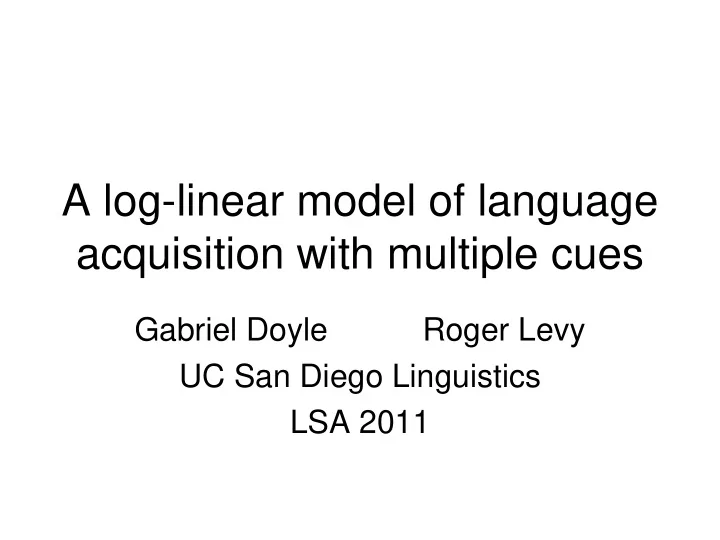

A log-linear model of language acquisition with multiple cues Gabriel Doyle Roger Levy UC San Diego Linguistics LSA 2011
mommyisntherenoweatyourapple
transition probabilities stress patterns X mommyisntherenoweatyourapple S W phonotactics allophonic variation coarticulation
no single sufficient cue Vowel Categorization Vallabha et al 2007, PNAS
Learning from Multiple Cues • Linguistic problems can have multiple partially informative cues • Need for models that learn to use cues jointly
The log-linear multi-cue model • General computational model for learning structures from multiple cues • Specific implementation in word segmentation using transition probabilities and stress patterns
Outline • The Multiple-Cue Problem • Case study: Word Segmentation • Log-linear multiple-cue model • Experimental testing
Case Study: Word Segmentation • Transition probabilities – p(B|A): probability that, having seen A, you’ll see B next Point to the monkey with the hat p(key|mon) = 1 p(hat|the) = 1/2 – Lower TP suggests separate words – 8 month old infants use TPs to segment artificial languages (Saffran et al 1996, a.o.)
Case Study: Word Segmentation • Stress patterns – English has trochaic (Strong-Weak) bias Dou ble, dou ble, toil and trou ble; Fi re burn and caul dron bu bble – 90% of content words start strong (Cutler & Carter 1987) – 7.5 month old English learners segment trochaic but not iambic words (Jusczyk et al 1999)
Existing segmentation models • Single cue-type (phonemes) – Bayesian MDL models (Goldwater et al 2009) – PUDDLE (Monaghan & Christiansen 2010) • Multi cue-type (phonemes & stress) – Connectionist (Christiansen et al 1998) – Algorithmic (Gambell & Yang 2006)
Why a log-linear model? • Ideal learner model; other multi-cue models aren’t • Effective in other linguistic tasks (Hayes & Wilson 2008, Poon et al 2009) • More flexible than other models – new cues become new features – overlapping cues are easy to incorporate
Log-linear modelling • Model learns a probability distribution Weighted sum of feature fns • Feature functions f j map (W,S) pairs to real numbers • “Learning” means finding good real number weights λ for features
Feature functions mommy ate it • Transition probabilities mmy|mo:1 – Bigram counts within words • Stress templates SW:1, S:2 – Stress “word” counts • Lexical – Word counts mommy:1, ate:1, it:1 • MDL Prior – Lexicon length length:10
“Normalizing” the probability Normalization constant • Probabilities need to be normalized • Usually divide by sum • But this sum is intractable
Contrastive estimation all possible corpora observed corpus . contrast set
Contrastive estimation (Smith & Eisner 2005) • Contrast set as focused negatives – Want to put probability mass on grammatical outcomes – AND remove mass from ungrammaticals • Good contrast sets can cause quicker convergence
Our contrast set • Set of all corpora from transposing two syllables in observed corpus Observed mommy ate it corpus mmymo ate it Note: not the only Ungrammatical possible contrast set contrasts mo ate mmy it “Grammatical” mommy it ate contrast
Learning the weights λ • Weights estimated using gradient ascent Expected feature value on observed corpus Prior Expected feature value on contrast set • Weight increases when feature appears in observed, decreases when it appears in contrast • Prior pulls weight toward initial bias µ i
Experimental Questions • Verification: Does it learn the stress biases that children exhibit? Training on child- directed English • Application: Can these biases explain age effects in word segmentation? Testing on artificial language
Thiessen & Saffran 2003 • Synthesized bisyllabic language, either all SW or all WS • 7 & 9 month olds, learning English • Preferential looking after exposure • Words & part words in opposition
Thiessen & Saffran 2003 SW Lang DApuDObiBUgoDApuBUgo 7 mos: dobi > bibu Both ages segment 9 mos: dobi > bibu by TPs & stress bias WS Lang daPUdoBIbuGOdaPUbuGO 7 mos: dobi > bibu 7 mos seg by TPs 9 mos: dobi < bibu 9 mos seg against TPs & with stress bias
Experimental Design • Train on English child-directed speech – 1638 words of Pearl-Brent database – 266 SW, 35 WS; 80% monosyllabic – Stress determined by CMU Pron Dict – Utterance & syllable boundaries included, non-utterance word boundaries not given – no prior knowledge given
Weights learned from child-directed English 0.4 0.35 0.3 Learned weight 0.25 0.2 λ WS λ SW 0.15 0.1 0.05 0 1 -0.05 -0.1 -0.15 Trochaic bias, SW > WS Mean λ SW – λ WS = .262 ± .119 [p < .001]
Age effects • Idea: older infants have stronger confidence in language parameters • Strength of learned priors increases to simulate increased linguistic experience prior strength prior value
Age effects 9 months 7 months 10 4.5 Word 9 4 Partword Looking time Word 8 Looking time 3.5 Partword 7 3 6 2.5 5 2 4 1.5 3 1 2 0.5 1 0 0 SW WS SW WS SW WS “Young” model “Old” model 0.35 0.05 0.3 0.25 Word 0.04 Word Word score Word score 0.2 Partword Partword 0.03 0.15 0.1 0.02 0.05 0.01 0 0 -0.05 -0.1 -0.01 -0.15 -0.02 -0.2 SW WS SW WS -0.03
Conclusions • Model learns stress bias from unsegmented data • Model shows similar behavioral change to infants learning a language • Behavioral change can result strictly from exposure, not a change in the segmentation method
Future Extensions • Expand set of cues (e.g., phonotactics) • Additional experimental applications • Move into other linguistic problems
Thank you! gdoyle@ling.ucsd.edu
Recommend
More recommend